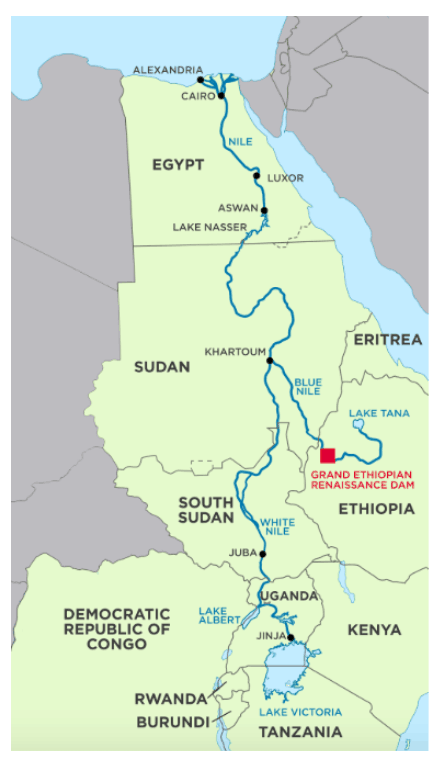UPSC Articles
International Affairs
Topic: General Studies 3:
- Policies and politics of developed and developing countries
Grand Ethiopian Renaissance Dam (GERD) :A dam of contention in Africa

Daily Current Affairs IAS | UPSC Prelims and Mains Exam – 16th March 2020
Pic Source
About GERD
- It was formerly known as the Millennium Dam and sometimes referred to as Hidase Dam
- It will be Africa’s biggest hydropower project (6.45 GW) when completed as well as the seventh largest in the world
- The hydroelectric dam is being built on the world’s longest river Nile (north-flowing river in Africa), in the lowlands of Ethiopia.
- GERD’s storage capacity of 74 billion cubic meters of water (Bhakra Dam in India on Sutlej river has maximum capacity of 9 billion cubic meters of water)
- Ethiopia began construction in 2011 (think political turmoil in Egypt at that time!)at a cost of $4 billion and is approximately 70% complete as of Nov 2019
- Ethiopia wants to fill up the gigantic reservoir in 6 years
However, the mega dam has caused a row between Egypt and Ethiopia, with Sudan caught in between, which some fear could lead to war, and the US is now helping to mediate.
Significance of the dam for Ethiopia
- Ethiopia, Africa’s second-most populated country and a manufacturing hub, views the mega dam as a symbol of its sovereignty.
- Bridges Infrastructure Gap: Ethiopia has an acute shortage of electricity, with 60% of its population not connected to the grid.
- Export Potential: The energy generated will be enough to have its citizens connected and sell the surplus power to neighbouring countries.
- Economic Resurgence: There is an element of national pride in the timely completion of the GERD, as Ethiopia’s recent economic resurgence has revived the old vision of Great Ethiopia.
- Politically Important: There is also a lot at stake for the government of Mr. Ahmed (PM of Ethiopia), who faces a difficult general election this year after the euphoria of the 2018 peace process with Eritrea has largely faded.
Does anyone else benefit?
- Yes. Neighbouring countries including Sudan, South Sudan, Kenya, Djibouti and Eritrea are likely to benefit from the power generated by the dam.
- Many of these countries have huge power deficits.
- For Sudan there is the added advantage that the flow of the river would be regulated by the dam – meaning it would be the same all-year round.
- Usually the country suffers from serious flooding in August and September.
Concerns Raised by Egypt
- Egypt fears the project will allow Ethiopia to control the flow of Africa’s longest river
- Hydroelectric power stations do not consume water, but the speed with which Ethiopia fills up the dam’s reservoir will affect the flow downstream.
- The longer it takes to fill the reservoir, the less impact there will be on the level of the river.
- Heart of the dispute: Ethiopia wants to fill the reservoir in 6 years whereas Egypt wants to fill the reservoir, between 10 and 21 years, and for the release of a minimum of 40 billion cubic metres annually.
- Egypt, which relies on the Nile for 90% of its freshwater supply, is apprehensive that a rapid filling of the reservoir in upstream Ethiopia would cause a drastic reduction in supplies.
- Egypt perceives that the project would lead to diversion of waters to its own High Aswan Dam.
- Resistance by Egypt is rooted in History and Geopolitics:
- A 1929 treaty (and a subsequent one in 1959) gave Egypt and Sudan rights to nearly all of the Nile waters.
- The colonial-era document also gave Egypt veto powers over any projects by upstream countries that would affect its share of the waters.
- Neither agreement made any allowance for the water needs of the other riparian states that were not parties to the deal, including Ethiopia, Uganda, Kenya and Rwanda.
- Lack of Consultation: Ethiopia has said it should not be bound by the decades-old treaty and went ahead and started building its dam at the start of the Arab Spring in March 2011 without consulting Egypt.
Challenges Ahead
- Ethiopia has stated that the dispute over the dam project is only a trilateral issue involving Egypt and Sudan.
- Ethiopia asserts its rights for an equitable share of the Blue Nile flows from the Cooperative Framework Agreement (CFA) signed by some of the 10 Nile Basin Initiative nations
- The establishment of the Nile River Basin Commission mandated by the CFA has not materialised so far.
- Ethiopia is concerned that a long delay in filling the reservoir would jeopardise returns on its investments and hamper the prospects for overall growth.
- The mediation role played by US highlights the significance of the issue and the potential conflict it holds if unresolved. However, the mediation has not been able to progress substantially due to lack of true intentions from both sides.
- Impact regional & International Trade: An escalated tensions between Ethipia & Egypt would threaten the vital international trade route through the Suez Canal and along the Horn of Africa.
Way forward
- An agreement involving Egypt, Ethiopia and others river basin countries for equitable sharing of water
- Sustainable use of river water given the ever increasing problem of pollution and climate change.
- These countries can take inspiration from Indus Water Treaty signed between India and Pakistan brokered by World Bank in 1960. The treaty has been functioning smoothly and has endured three wars over nearly six dacades.
Conclusion
- The challenges for the fair utilisation of waters among the riparian states have only been compounded by the pressures of population growth and the effects of global warming
- While the parties have sought international mediation they also need to rely on regional cooperation for long enduring solution.













